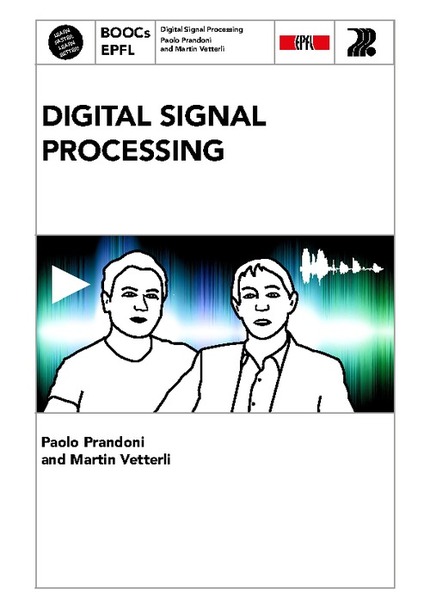Présentation
This course will provides you the fundamentals of Digital Signal Processing from the ground up. Starting from the basic definition of a discrete-time signal, you will go through Fourier analysis, filter design, sampling, interpolation and quantization to build a DSP toolset complete enough to analyze a practical communication system in detail. Hands-on examples and demonstration will be routinely used to close the gap between theory and practice.
These lectures note are part of the BOOC series (Book and Open Online Courses), a collection of reading material supporting the MOOCs (Massive Open Online Courses) provided by the Ecole Polytechnique Fédérale de Lausanne. These documents ideally complement the course, as they help revising the MOOC and obtain the certificate.
Sommaire
- Module 1: Introduction to Digital Signal Processing – Discrete Time Signals – How Does Your PC Play Discrete-Time Sound? – The Karplus-Strong Algorithm – Complex Exponentials
- Module 2: Signal Processing and Vector Spaces – Vector Space – Signal Space – Bases – Subspace-Based Approximation
- Module 3: The Frequency Domain – The DFT as a Change of Basis – The Definition of DFT – Examples of DFT Calculation – Interpreting a DFT Plot – DFT Analysis – DFT Example – Analysis of Musical Instruments – DFT Synthesis – DFT Example: Tide Prediction in Venice – DFT Example: MP3 Compression – The Short-Time Fourier Transform – The Spectrogram – Time-Frequency Tiling – Discrete Fourier Series – Karplus-Strong Revisited and DFS – Karplus-Strong Revisited and DTFT – Existence and Properties of the DTFT – The DTFT as a Change of Basis – Sinusoidal Modulation – Tuning a Guitar
- Module 4: Linear Time-Invariant Filters – Convolution – The Moving Average Filter – The Leaky Integrator – Filter Classification in the Time Domain – Filter Stability – The Convolution Theorem – Examples of Frequency Response – Filter Classification in the Frequency Domain – The Ideal Lowpass Filter – Ideal Filters Derived from the Ideal Lowpass Filter – Demodulation Revisited – Impulse Truncation and Gibbs Phenomenon – Window Method – Frequency Sampling – The z-Transform – Region of Convergence and Stability – Intuitive IIR Design – Filter Specification – IIR Design – FIR design
- Module 5: The Continuous-Time Paradigm – Continuous-Time Signal Processing – Polynomial Interpolation – Local Interpolation – The Spectrum of Interpolated Signals – The Space of Band-Limited Functions – The Sampling Theorem – Raw Sampling – Sinusoidal Aliasing – Aliasing for Arbitrary Spectra – Sampling Strategies – Stochastic Signal Processing – Quantization
- Module 6: The Success Factors for Digital Communication – Constraints of the Analog Channel – The Design Problem – Upsampling – Fitting the Transmitter Spectrum – Noise and Probability of Error – PAM and QAM – Modulation and Demodulation – Design Example – Receiver Design – Delay Compensation – Adaptive Equalization – ADSL Design – Discrete Multitone Modulation
Informations
Editeur : EPFL Press
Collection : BOOCs EPFL
Publication : 1 juillet 2017
Edition : 1ère édition
Support(s) : eBook [PDF]
Nombre de pages eBook [PDF] : 91
Taille(s) : 9,6 Mo (PDF)
Langue(s) : Anglais
EAN13 eBook [PDF] : 9782889144259
Du même auteur
Dans la même collection
Economie du sol et de l’immobilier I BOOCs EPFL
0,00 € (gratuit)
Economie du sol et de l'immobilier II BOOCs EPFL
0,00 € (gratuit)
Systèmes d’Information Géographique 2 BOOCs EPFL
Stéphane Joost, Marc Soutter, Fernand Kouamé, Amadou Sall
0,00 € (gratuit)
Introduction to astrophysics BOOCs EPFL
0,00 € (gratuit)
Ecological monitoring BOOCs EPFL
Geoffroy Mauvais, Béatrice Chataigner, Victor M. Panaretos, Emmanuel M. Hema, Inza Kone
0,00 € (gratuit)
Ils ont aussi acheté
Terre L'histoire de notre planète de sa naissance à sa disparition
30,80 €
Accomplissement des tâches communales en Suisse Organisation, responsabilités et effets
Andreas Ladner, Alexander Haus
0,00 € (gratuit)
Les secrets des interrogatoires et des auditions de police Traité de tactiques, techniques et stratégies
37,00 €
Comment tout finira (astrophysiquement parlant)
20,85 €
L'AN 1000 Quand les explorateurs ont connecté le monde et que la globalisation est née
23,25 €
Sur des thèmes similaires
Introduction aux sciences de l'information Entropie, compression, chiffrement et correction d'erreurs
Jean-Yves Le Boudec, Patrick Thiran, Rüdiger Urbanke
À partir de 9,90 €
Logique élémentaire Cours de base pour informaticiens
39,99 €






